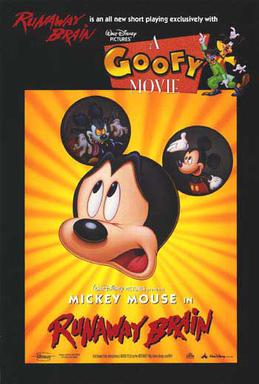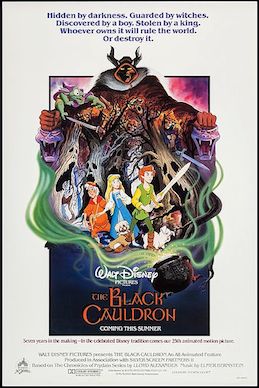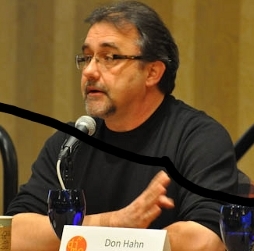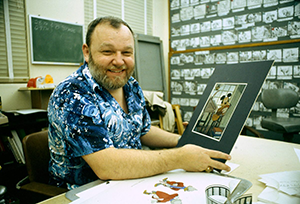Related Research Articles
Modern animation in the United States from the late 1980s to 2004 is frequently referred to as the renaissance age of American animation. During this period, many large American entertainment companies reformed and reinvigorated their animation departments, following the dark age, and the United States had an influence on global and worldwide animation.

The Great Mouse Detective is a 1986 American animated mystery adventure film produced by Walt Disney Feature Animation and released by Walt Disney Pictures. Based on the children's book series Basil of Baker Street by Eve Titus and Paul Galdone, the film is written and directed by John Musker, Dave Michener, Ron Clements, and Burny Mattinson in their feature directorial debuts. Featuring the voices of Vincent Price, Barrie Ingham, Val Bettin, Susanne Pollatschek, Candy Candido, Diana Chesney, Eve Brenner, and Alan Young, the plot follows a mouse detective who undertakes to help a young mouse find and save her father from the criminal mastermind Professor Ratigan.

Oliver & Company is a 1988 American animated musical adventure film produced by Walt Disney Feature Animation and released by Walt Disney Pictures. It is loosely based on the Charles Dickens novel Oliver Twist. In the film, Oliver is a homeless kitten who joins a gang of dogs to survive in the streets. Among other changes, the setting of the film was relocated from 19th century London to 1980s New York City, Fagin's gang is made up of dogs, and Sykes is a loan shark.

Jeffrey Katzenberg is an American media proprietor and film producer who has been serving as president of Universal Animation Studios. He previously served as chairman of Walt Disney Studios from 1984 to 1994, a position in which he oversaw production and business operations for the company's feature films. Following his departure, he co-founded DreamWorks SKG in 1994, where he served as the company's chief executive officer (CEO) and executive producer of its animated franchises—including Shrek, Madagascar, Kung Fu Panda, and How to Train Your Dragon—until stepping down from the title in 2016. He has since founded the venture capital firm WndrCo in 2017, which invests in digital media projects, and launched Quibi in 2020, a defunct short-form mobile video platform that lost US$1.35 billion in seven months.

Runaway Brain is a 1995 American animated comedy horror short film produced by Walt Disney Feature Animation. Featuring Mickey Mouse and Minnie Mouse, the short centers on Mickey attempting to earn money to pay for an anniversary gift for Minnie. He responds to an advertisement to work for Doctor Frankenollie, only to find out that he is looking for a donor to switch brains with the monster he created. Featuring animation by animator Andreas Deja, it was first released in 1995 attached to North American theatrical showings of A Kid in King Arthur's Court and in 1996 attached to international theatrical showings of A Goofy Movie. It would be the final original Mickey Mouse theatrical animated short until Get a Horse! in 2013.

The Black Cauldron is a 1985 American animated dark fantasy adventure film produced by Walt Disney Productions in association with Silver Screen Partners II and released by Walt Disney Pictures. It is loosely based on the first two books in The Chronicles of Prydain by Lloyd Alexander, a series of five novels that are in turn based on Welsh mythology.

Walt Disney Animation Studios (WDAS), sometimes shortened to Disney Animation, is an American animation studio that produces animated feature films and short films for The Walt Disney Company. The studio's current production logo features a scene from its first synchronized sound cartoon, Steamboat Willie (1928). Founded on October 16, 1923, by brothers Walt Disney and Roy O. Disney after the closure of Laugh-O-Gram Studio, it is the longest-running animation studio in the world. It is currently organized as a division of Walt Disney Studios and is headquartered at the Roy E. Disney Animation Building at the Walt Disney Studios lot in Burbank, California. Since its foundation, the studio has produced 63 feature films, with its first release being Snow White and the Seven Dwarfs (1937), which is also the first hand drawn animated feature film, and its most recent release was Moana 2 (2024). The studio has also produced hundreds of short films.

Andreas Deja is a Polish-born German-American character animator most noted for his work at Walt Disney Animation Studios. Deja's work includes serving as supervising animator on characters in several Disney animated films, including the Disney villains Gaston in Beauty and the Beast, Jafar in Aladdin, and Scar in The Lion King, the titular character in Hercules, and Lilo Pelekai in Lilo & Stitch.

Wolfgang Reitherman, also known and sometimes credited as Woolie Reitherman, was a German-American animator, director and producer. As a member of the "Nine Old Men" at Walt Disney Productions, Reitherman was known for his action-oriented animation.

Sleeping Beauty is a 1959 American animated musical fantasy film produced by Walt Disney Productions and released by Buena Vista Film Distribution. Based on Charles Perrault's 1697 fairy tale, the film follows Princess Aurora, who was cursed by the evil fairy Maleficent to die from pricking her finger on the spindle of a spinning wheel on her 16th birthday. She is saved by three good fairies, who alter Aurora's curse so that she falls into a deep sleep and will be awakened by true love's kiss. The production was supervised by Clyde Geronimi, and was directed by Wolfgang Reitherman, Eric Larson, and Les Clark. It features the voices of Mary Costa, Bill Shirley, Eleanor Audley, Verna Felton, Barbara Luddy, Barbara Jo Allen, Taylor Holmes, and Bill Thompson.

Gary Trousdale is an American animator, film director, screenwriter and storyboard artist. He is best known for directing films such as Beauty and the Beast (1991), The Hunchback of Notre Dame (1996), and Atlantis: The Lost Empire (2001). He frequently works with Kirk Wise and Don Hahn.

Ronald Francis Clements is an American animator, film director, screenwriter, and film producer. He often collaborates with fellow director John Musker and is best known for writing and directing the Disney animated films The Great Mouse Detective (1986), The Little Mermaid (1989), Aladdin (1992), Hercules (1997), Treasure Planet (2002), The Princess and the Frog (2009), and Moana (2016).

Donald Paul Hahn is an American film producer. He served as a producer for the Disney films Beauty and the Beast, The Lion King and The Hunchback of Notre Dame.

John Edward Musker is an American animator, film director, screenwriter, and film producer. He often collaborates with fellow director Ron Clements and is best known for writing and directing the Disney animated films The Great Mouse Detective (1986), The Little Mermaid (1989), Aladdin (1992), Hercules (1997), Treasure Planet (2002), The Princess and the Frog (2009), and Moana (2016).

Leslie James Clark was an American animator and the first of Disney's Nine Old Men, joining Walt Disney Productions in 1927.

Kenneth B. "Ken" Anderson was an American animator, art director, and storyboard artist for The Walt Disney Company. He had been named by Walt Disney as his "jack of all trades".

Burnett Mattinson was an American animator, director, producer, and story artist for Walt Disney Productions/Walt Disney Animation Studios, where he was employed from 1953 until his death in 2023.

Waking Sleeping Beauty is a 2009 American documentary film directed by Disney film producer Don Hahn and produced by Hahn and former Disney executive Peter Schneider. The film documents the history of Walt Disney Feature Animation from 1984 to 1994, covering the rise of a period referred to as the Disney Renaissance.
Percival C. Pearce was an American producer, director, and writer, best known for his work with Walt Disney Productions.

Dream On Silly Dreamer is a 2005 American documentary film directed by Dan Lund and produced by Tony West. Lund and West were both special effects animators at Walt Disney Feature Animation, and the film chronicles the rise and fall of traditional animation at The Walt Disney Company from 1980 to 2005.
References
- ↑ Ghez 2011, pp. 514–515.
- 1 2 3 4 Ghez 2011, p. 515.
- 1 2 Sammon, Paul M. (Spring 1980). "Inside The Black Hole: As Told by Disney's Special Effects Experts". Cinefantastique . Vol. 9, no. 3–4. pp. 29–31. Retrieved July 24, 2024– via Internet Archive.
- ↑ Ghez 2011, pp. 515–516.
- ↑ Ghez 2011, p. 516.
- ↑ Ghez 2011, p. 517.
- ↑ Ghez 2011, p. 518.
- ↑ Ghez 2011, p. 519.
- ↑ Ghez 2011, pp. 521, 526.
- ↑ Ghez 2011, pp. 521–522, 527–528.
- ↑ Ghez 2011, pp. 522–523.
- 1 2 Ghez 2011, p. 526.
- ↑ Wilson, Steven S. (Summer 1979). "The Black Hole". Cinefantastique. Vol. 8, no. 4. p. 32. Retrieved June 29, 2024– via Internet Archive.
- ↑ "The 52nd Academy Awards". Academy of Motion Picture Arts and Sciences . March 2022. Archived from the original on March 19, 2024. Retrieved June 29, 2024.
- 1 2 Blowen, Michael (August 3, 1985). "'Black Cauldron' A Brew Of Vintage Disney Animation". The Boston Globe . Archived from the original on April 7, 2019. Retrieved July 21, 2024– via Chicago Tribune.
- 1 2 3 4 5 Noyer, Jérémie (September 17, 2010). "The Black Cauldron: Producer Joe Hale talks munchings and crunching..." Animated Views (Interview). Archived from the original on February 22, 2024. Retrieved June 29, 2024.
- ↑ Ghez 2011, p. 544.
- ↑ Hulett 2014, p. 48.
- ↑ Ghez 2019, p. 545.
- ↑ Stewart 2005, p. 68.
- ↑ Stewart 2005, pp. 68–70.
- 1 2 Stewart 2005, p. 70.
- ↑ "Disney animator hits the heights". San Diego Union Tribune . July 28, 2008. Archived from the original on July 24, 2024. Retrieved July 24, 2024.